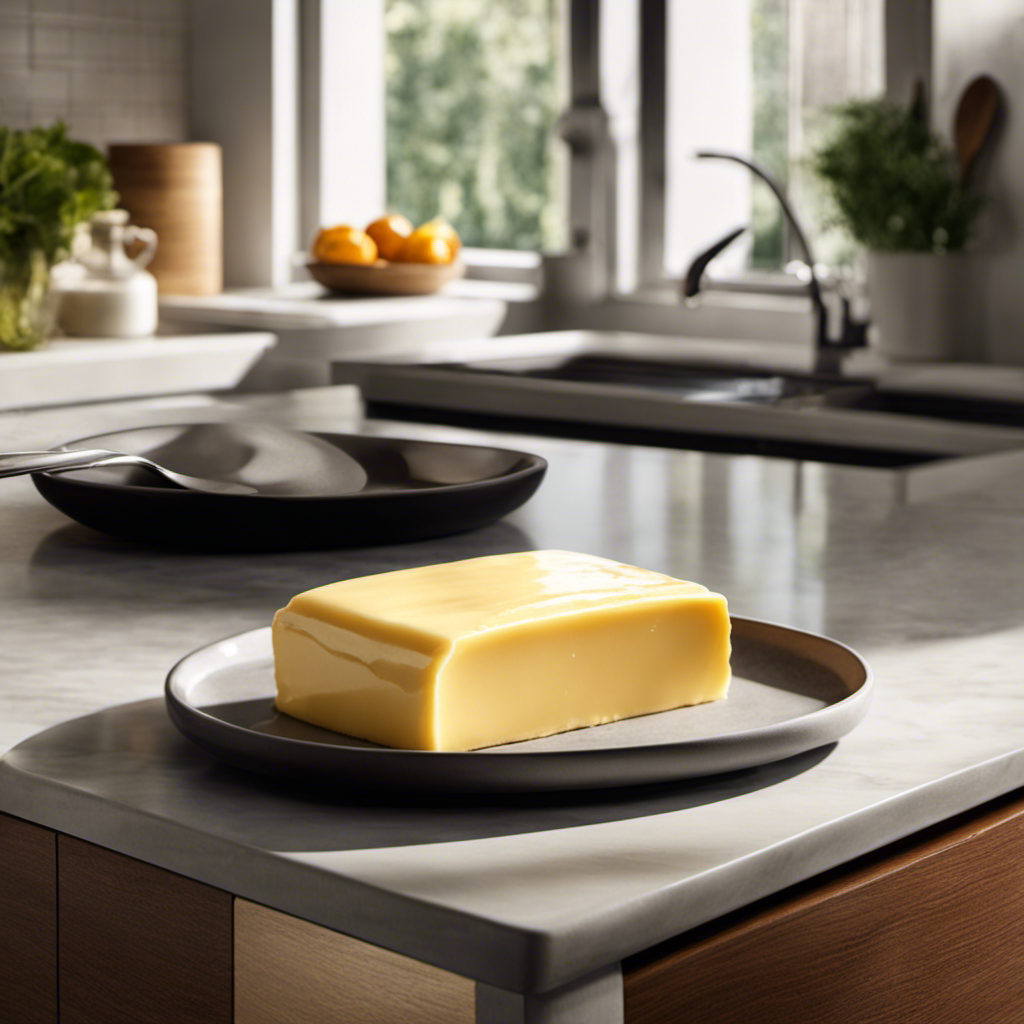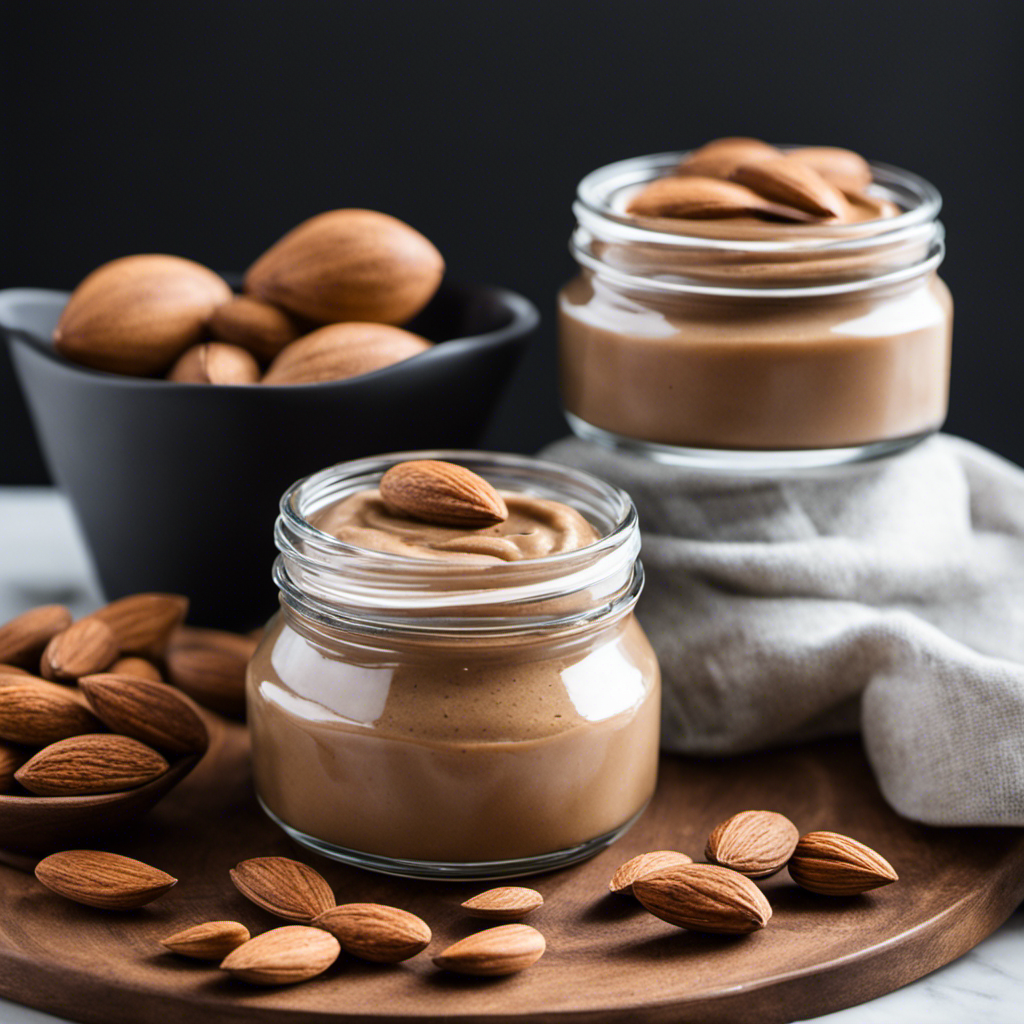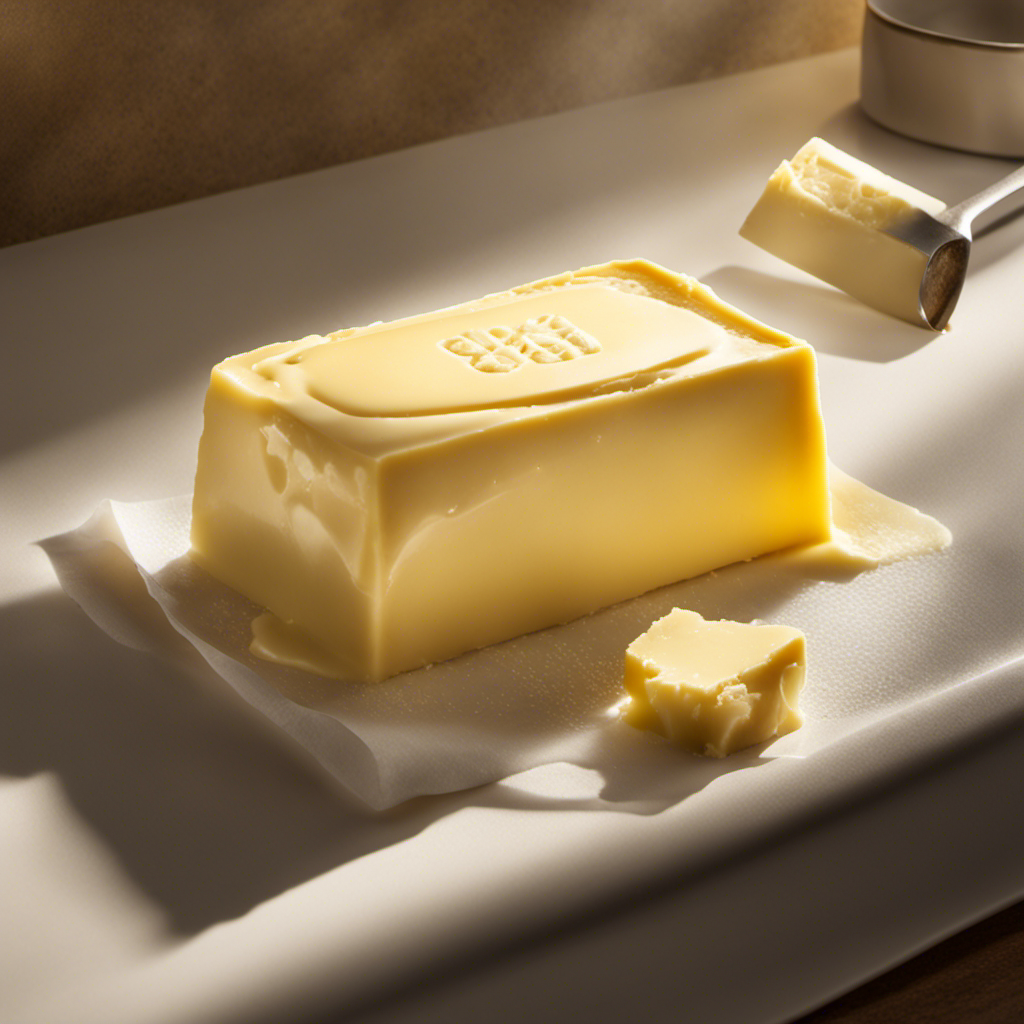Did you realize that compound butter has a longer shelf life compared to regular butter? It can actually remain fresh for up to two weeks if stored correctly.
Hi, I’m here to guide you through the ins and outs of the shelf life of compound butter. We’ll explore the factors that affect its longevity, recommended storage methods, signs of spoilage, and even ways to extend its freshness.
So let’s dive in and ensure that your compound butter stays delicious for as long as possible!
Key Takeaways
- Compound butter typically lasts for 1-2 weeks in the refrigerator, but freezing can extend its shelf life up to 6 months.
- Thaw frozen compound butter in the refrigerator overnight before use.
- Properly label the frozen compound butter with the date of preparation and type for easy identification.
- Storing compound butter in an airtight container in the refrigerator helps maintain its freshness and prevents odor transfer.
The Shelf Life of Compound Butter
You should know that compound butter typically lasts for about one to two weeks in the refrigerator. However, if you want to extend its shelf life, you can consider freezing it.
When stored properly in the freezer, compound butter can last for up to six months. To freeze compound butter, wrap it tightly in plastic wrap or place it in an airtight container. Proper labeling is crucial to ensure you can easily identify and use the butter later. Write the date of preparation and the type of compound butter on the label.
When you’re ready to use it, simply thaw the frozen compound butter in the refrigerator overnight.
Now that you know how to store compound butter, let’s explore the factors that affect its longevity.
Factors Affecting the Longevity of Compound Butter
When properly stored, factors like temperature and moisture levels can affect how long your compound butter stays fresh.
There are several factors that can impact the spoilage of compound butter, including the ingredients used. For example, if you incorporate fresh herbs or garlic into your compound butter, it may have a shorter shelf life compared to plain butter. This is because the moisture content in these ingredients can promote the growth of bacteria and mold.
Additionally, the temperature at which the compound butter is stored plays a crucial role in its longevity. Keeping it refrigerated at a temperature below 40°F (4°C) can help extend its freshness.
It is important to note that compound butter should be used within a reasonable timeframe to ensure its quality and safety.
Recommended Storage Methods for Compound Butter
To keep your compound butter fresh for as long as possible, it’s important to store it in an airtight container in the refrigerator. This will prevent any moisture or odors from affecting its quality.
When properly stored, compound butter can last for up to two weeks. However, it’s always best to check for any signs of spoilage before using it.
To ensure the recommended serving size, it’s helpful to shape the butter into individual portions using an ice cube tray or small molds. This way, you can easily grab one serving at a time without having to thaw the entire batch.
If you’re looking for creative compound butter recipes, consider experimenting with different herbs, spices, and even fruits to add a unique flavor twist to your dishes.
Signs of Spoiled Compound Butter
When it comes to identifying spoiled compound butter, there are a couple of key signs to look out for.
The first is visual mold growth, which can appear as fuzzy patches or spots on the surface of the butter.
Additionally, an off-putting odor may be present, indicating that the butter has gone bad.
It’s important to be aware of these signs to ensure that you’re using fresh and safe compound butter in your cooking.
Visual Mold Growth
You can easily spot visual mold growth on compound butter by looking for fuzzy or discolored patches. Mold prevention is important when it comes to food safety, and visual inspection is a crucial step in determining if your compound butter has gone bad. Here is a table that provides further information on how to identify mold growth on compound butter:
| Type of Mold | Appearance | Characteristics |
|---|---|---|
| Penicillium | Blue-green | Fuzzy texture |
| Aspergillus | Green | Powdery surface |
| Cladosporium | Black | Dark, fuzzy |
| Alternaria | Brown | Velvety texture |
| Fusarium | Pink | Slimy surface |
Off-Putting Odor
Avoid sniffing compound butter that emits a foul odor as it may indicate spoilage. When it comes to preserving the aroma of compound butter, an offensive smell is a clear sign that something has gone wrong.
The offensive smell in compound butter could be caused by bacterial growth or rancidity. Bacterial growth occurs when harmful bacteria multiply in the butter, leading to the production of unpleasant odors. On the other hand, rancidity is caused by the oxidation of fats in the butter, resulting in a sharp, unpleasant smell.
To prevent this, it is essential to store compound butter properly in an airtight container in the refrigerator. Additionally, using fresh, high-quality ingredients and consuming the butter within the recommended time frame will help maintain its aroma and quality.
How to Extend the Freshness of Compound Butter
When it comes to keeping my compound butter fresh, I have found that following a few storage tips is essential.
First, I make sure to store it in an airtight container in the refrigerator to maintain its freshness.
Second, I always use proper refrigeration techniques, such as keeping it away from strong-smelling foods to avoid any flavor transfer.
Lastly, to maximize the shelf life of my compound butter, I try to consume it within a week or freeze it for longer storage.
Storage Tips for Freshness
For optimal freshness, it’s best to store compound butter in an airtight container in the refrigerator.
When using compound butter in recipes, there are a few tips to keep in mind.
First, try spreading it on grilled vegetables or bread for an extra burst of flavor. It can also be used to enhance the taste of grilled meats or seafood.
For a creative twist, experiment with different flavor combinations such as garlic and herb, lemon and dill, or even truffle and Parmesan. These unique flavors can elevate any dish to a whole new level.
Now, let’s move on to proper refrigeration techniques to ensure your compound butter stays fresh and delicious for as long as possible.
Proper Refrigeration Techniques
To keep your compound butter fresh, make sure to store it in an airtight container in the refrigerator. Refrigeration is key to maintaining the quality and safety of your compound butter. The ideal temperature for storing compound butter is between 32°F and 40°F (0°C and 4°C). This helps to slow down bacterial growth and preserve the flavors of the added ingredients. It is important to note that compound butter should not be kept at room temperature for more than a few hours, as it can spoil quickly. By storing it in the refrigerator, you can extend its shelf life and enjoy it for a longer period of time.
Here is a table summarizing the recommended refrigeration temperature and storage time for compound butter:
| Temperature Range | Storage Time |
|---|---|
| 32°F – 40°F | 1-2 weeks |
Remember to label your airtight container with the date of preparation to keep track of its freshness.
Maximizing Shelf Life
You can extend the shelf life of your compound butter by storing it in an airtight container in the refrigerator. This is important for maximizing flavor and preventing bacterial growth.
By keeping the butter in an airtight container, you are creating a barrier that helps to maintain its freshness. This prevents any unwanted odors or flavors from seeping into the butter and altering its taste.
Additionally, storing it in the refrigerator helps to slow down the growth of bacteria, which can lead to spoilage and foodborne illnesses.
It is recommended to consume the compound butter within 1-2 weeks for optimal freshness. Remember to always check for any signs of spoilage, such as a rancid smell or mold growth, before using the butter.
Proper Handling and Hygiene Practices for Compound Butter
Proper handling and hygiene practices ensure that compound butter stays fresh and safe to eat. To maintain the quality and safety of your compound butter, it is essential to follow these food safety precautions:
- Always wash your hands thoroughly before handling the butter to prevent the transfer of bacteria or contaminants.
- Use clean utensils and surfaces when working with compound butter to avoid cross contamination.
- Store compound butter in an airtight container in the refrigerator to keep it fresh for longer.
By implementing these practices, you can reduce the risk of foodborne illnesses and extend the shelf life of your compound butter.
Remember to check for any signs of spoilage, such as off smells or discoloration, before consuming. Safety should always be a top priority when handling and storing food products.
Safe Consumption Guidelines for Compound Butter
When consuming compound butter, it’s important to be aware of the expiration date and any signs of spoilage. Compound butter is a versatile ingredient that can add flavor to a variety of dishes. Whether you’re using it in compound butter recipes or finding creative uses for compound butter, it’s crucial to ensure its safety for consumption.
Firstly, always check the expiration date on the packaging. Using compound butter past its expiration date can lead to foodborne illnesses. Additionally, pay attention to any signs of spoilage, such as an off smell or mold formation. If you notice any of these signs, it’s best to discard the compound butter to avoid any health risks.
To prolong the shelf life of compound butter, store it properly in the refrigerator. It’s recommended to consume compound butter within two weeks of opening. If you’re not planning to use it all, consider freezing it in small portions for later use.
Frequently Asked Questions
Can I Freeze Compound Butter to Extend Its Shelf Life?
Yes, you can freeze compound butter to extend its shelf life. Freezing is a great way to preserve it for longer. Alternatively, you can also store it in an airtight container in the refrigerator.
Can I Use Compound Butter Past Its Expiration Date if It Looks and Smells Fine?
Using expired compound butter in cooking can pose potential risks to your health, regardless of its appearance or smell. It’s important to prioritize food safety and discard any expired products to avoid foodborne illnesses.
Is It Safe to Store Compound Butter at Room Temperature?
It is not safe to leave compound butter at room temperature as it can promote the growth of bacteria. Compound butter should be stored in the refrigerator to maintain its freshness and prevent foodborne illnesses.
Can I Use Compound Butter That Has Been Left Out Overnight?
Leaving compound butter out overnight can raise safety concerns due to the risk of bacterial growth. It’s best to refrigerate compound butter to ensure its freshness and prevent any potential foodborne illnesses.
How Can I Tell if Compound Butter Has Gone Bad?
To determine if compound butter has gone bad, check for any signs of spoilage such as a rancid smell, mold, or an off taste. It’s important to make sure you store and handle it properly to avoid spoilage.
Conclusion
In conclusion, it’s important to be mindful of the shelf life of compound butter to ensure its quality and safety. By following the recommended storage methods and properly handling the butter, you can extend its freshness and enjoy it for a longer period of time.
However, always be aware of the signs of spoiled compound butter and adhere to safe consumption guidelines.
So, why not indulge in the rich flavors of compound butter while maintaining good hygiene practices? Your taste buds will thank you!










